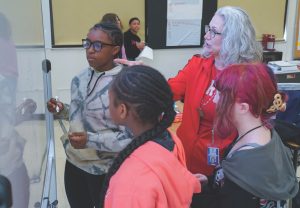Steady steps in the right direction. That’s how West Virginia Superintendent of Schools Michele Blatt describes the progress that the state is making in its educational areas of focus — stronger literacy and math skills by third grade, less absenteeism and more robust middle school engagement.

“Our state is moving in the right direction in education,” Blatt said. “There has been a great deal of change and disruption in education over the past several years, but I strongly believe we are now on a path that will continue to show growth across the state. It is critical that we stay the course and give initiatives time to work. Improving schools is a process and takes three to five years, but the gains we are seeing show we are on the right track.”
Despite these improvements, West Virginia faces financial hurdles in its education system. Per pupil spending in West Virginia is now below the national average by nearly $2,000, according to the Education Data Initiative. That makes West Virginia 27th in the nation for per-pupil spending, according to the National Education Association (NEA). The NEA also says average teacher pay in West Virginia is 48th in the nation at $55,516.
Statewide assessment results show that students in West Virginia’s public schools improved by three percentage points in English Language Arts (ELA) and two percentage points in math compared to last year. The data also indicates a decline in the number of students scoring at the “Does Not Meet Standard” level.
“Overall, 86% of our districts improved in English Language Arts and 83% improved in math,” Blatt said.
Meanwhile, 76% of West Virginia’s districts saw decreases in chronic absenteeism — defined as missing 18 days or more, whether excused or not. The state reduced the number of chronically absent students from 29.1% in 2022-2023 to 22.8% in 2024-2025, she said.
Another area of improvement is among students in Career and Technical Education (CTE) programs. Students in these programs take the NOCTI test, a national workforce readiness exam that provides certification once benchmarks have been met. Blatt said 68% of the state’s CTE students met or exceeded the career-ready benchmark this year — an increase of four percentage points from last year.


“We analyze a lot of data at the department and have been really focusing in on the data that will make the improvements we all want to see in education,” Blatt said. “Our focus goes beyond the statewide general summative assessment scores and looks at the individual scores of schools and students. It is important to determine if all students are progressing and moving through the performance levels.”
Additional measurements, beyond the NOCTI and the general summative assessment (a yearly test for students in third through eighth grade and 11th grade), provide a more complete picture of student progress.
The Balanced Scorecard, for example, enables the department to determine whether 10th-grade students are on track to graduate, while the college-and-career-ready measure for 12th-grade students identifies those who have completed advanced coursework and/or CTE programs.
Benchmark Assessments, administered three times per year, make a significant impact in areas where students need intervention throughout the year. These assessments typically show improvement between fall and spring, as intended, Blatt said.
The Third Grade Success Act, passed by the West Virginia Legislature in 2023, enabled support for schools to identify needs and help students meet standards in literacy and mathematics. It’s working, Blatt said.
Upswing Labs recently released a report titled “Dynamic Districts and States Where and How Literacy Is Improving.” West Virginia ranked second in the nation, behind Mississippi, in sustained literacy growth over a three-year period. The report also highlighted districts for sustained literacy growth, including Cabell, Kanawha, Logan, Marion, Mercer, Monongalia, Ohio, Putnam and Raleigh counties.
These districts’ success is tied to strong instructional leadership and a focus on professional learning for teachers, Blatt said.
“These counties fully embraced the requirements of the Third Grade Success Act and fully supported their teachers and staff in implementation,” she said.
Now, West Virginia must continue that progress from the lower grades into upper elementary and middle schools, she said.
“Our middle schools are an area where academics decrease and behavior problems increase,” she said. “We are losing many students during this critical transition time for children. We are tackling this issue through a targeted focus on a specific group of middle schools to increase student achievement through increased engagement, flexible scheduling and a learning environment conducive to this age group.”
Some West Virginia schools will benefit from a collaboration with Huntington Bank to offer the Ron Clark Academy’s Ignite the Classroom program, which focuses on making learning more engaging for middle schoolers. Other projects going on in West Virginia schools include:
- The Classroom 2 Career program, which enables students to explore potential careers through job shadowing, paid and unpaid internships and even full apprenticeship opportunities.
- The Speakers’ Bureau, a program of West Virginia University and the West Virginia Public Education Collaborative, which connects businesses with middle school classrooms across the state. More businesses are encouraged to participate.
Another example is the Build It Up program at Scott Teays Elementary, where the Contractors Association of West Virginia partnered to bring six weeks of lessons highlighting various careers in the construction field.
“With an integration of content standards, they are looking to expand statewide,” Blatt noted.
Partnerships with Marshall University, the Department of Tourism, the West Virginia Chambers Foundation’s Jobs for West Virginia’s Graduates and the West Virginia Manufacturers Association are opening additional opportunities for middle and high school students. The department encourages and will work with businesses to establish internships and apprenticeships, Blatt said, with the goal of tailoring education programs to meet the state’s workforce needs.
“Different areas of our state have different workforce demands, and we must ensure we are partnering with the various businesses and organizations across the state to graduate students ready to pursue employment, future education or the military,” Blatt said. “Every student in our state deserves a plan upon graduation.”
She wants to see students fully engaged in their education and teachers respected and valued for the hard work they do each day, she added.
“We have many hurdles to overcome and statistics such as poverty rates and health metrics against us, yet we continue to make progress,” she said. “The support we have received from the business community is crucial to the long-term success of our education system. These partnerships are what make education relevant to our students, and we cannot be successful without them. It will take all of us working together to ensure West Virginia succeeds and flourishes in the future.”
